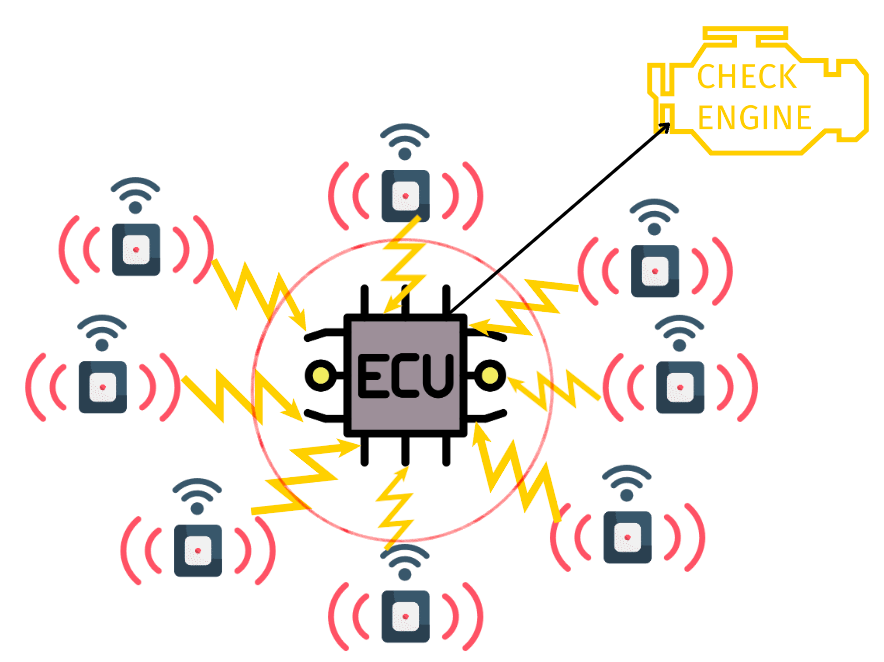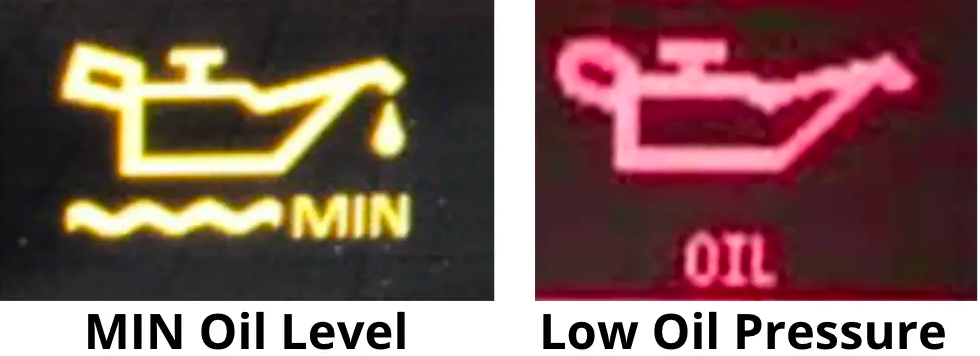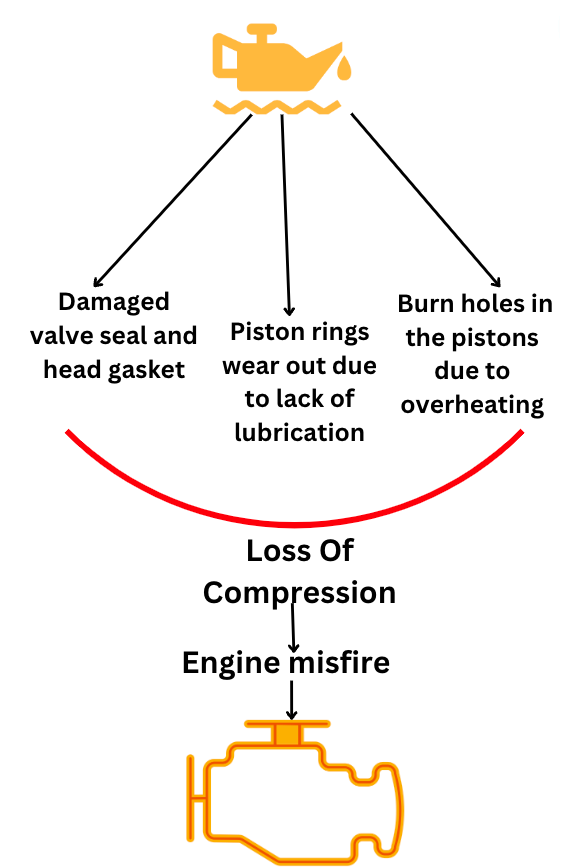Can Low Oil Cause Check Engine Light To Come On?
Low oil itself does not directly trigger the check engine light. However, low oil can lead to engine damage and other issues that cause the engine light to turn on. Specifically, low oil levels can result in lost compression, misfires, overheating, and dropped oil pressure. All of these mechanical problems in the engine affect combustion efficiency and can cause the check engine light to illuminate as a result. The light could also indicate issues with sensors, catalytic converter, oxygen sensor, fuel injectors or other components.
When it comes to our vehicles, we all know the dreaded feeling when the check engine light suddenly illuminates on the dashboard.
At that spot, you might wonder whether low oil can trigger the check engine light. In this article, we’ll explore this topic extensively and provide you with all the information you need.
Bonus Read: Check engine light after oil change
I’ve composed an interactive tool for you guys to assist in troubleshooting car difficulties. It guides you through uncomplicated steps. Ensure to give it a look.
- Check engine light can come on due to low oil because it causes engine damage like loss of compression and misfires.
- Oil light warns about low pressure or level. Check engine light indicates wider engine issues detected by sensors.
- Low oil pressure causes timing components like cam phasers to malfunction, leading to combustion issues.
- Without enough lubrication, heat and friction wears down seals, cylinder walls, piston rings. This reduces compression.
- Poor compression leads to inefficient, uneven combustion that upsets engine balance, causing vibration and misfires.
What Exactly Is The Check Engine Light?
The check engine light warns of issues in the engine. The ECU checks all engine parts for problems. It checks the engine temperature, air intake, fuel usage, exhaust, and more. The ECU is programmed on the optimal range of those signals sent by the sensors.
If a sensor’s signal moves out of the desired range, ECU knows a part likely has an issue. It then turns on the check engine light. The car may also go to limp mode to protect the engine from more damage.

The check engine light will stay on until the bad part gets fixed and the ECU gets reset. This light is to quickly warn of possible problems. Drivers can then fix issues before there is heavy damage.
The check engine light is usually yellow or orange-red. If it blinks red, there is likely a bad engine misfire. Serious engine issues like this need very fast fixing.
First Thing To Do When Check Engine Light Comes On
When the Check Engine Light illuminates, the vehicle’s ECU will generate a diagnostic trouble code (DTC). You should read the code with the help of the OBD2 scan tool to troubleshoot the problem. I would recommend BlueDriver scan tool.
Sometimes, intermittent errors occur in the engine and don’t set trouble code. You can find these codes in the pending trouble codes section of the Bluedriver scan tool.
Once you identify the meaning of the diagnostic trouble code that is illuminating the check engine light, you can find a specific area of the engine causing that problem.
Difference Between Oil Warning Light and Check Engine Light
The oil light is a warning system. It tells you when the oil in your engine is low. This happens because of oil leaks, bad oil filters, broken oil pumps, and faulty oil pressure sensor.
The Check Engine Light is different. It can show many problems, small or big. A loose gas cap can turn it on. So can an engine misfire. Sensors all over the engine and exhaust make it turn on.
The oil light looks like Aladin’s lamp with a drop. The Check Engine Light looks like an engine-shaped bulb.
If oil pressure is super low, the oil light turns red or flashes. Stop the engine right away if you see this! If the oil level is just a minimum low, the light turns yellow or orange. It will also have a wavy line under it.

Just low oil level won’t turn on Check Engine Light. But low pressure affects combustion. This will turn on the Check Engine Light. The oil light comes on first, before the Check Engine Light.
In What Way Low Oil Level Or Pressure Can Turn On Check Engine Light?
If the oil pressure is low due to the low oil level in the engine, it can cause the engine misfire, which will trigger the check engine light.
Low oil pressure can cause an engine misfire in following ways:
1. Cam Phaser Rattling
In variable valve timing engines, there is a part called the cam phaser. It controls when the inlet and exhaust valves open and close. The cam phaser is moved by hydraulic oil pressure. A solenoid valve regulates the oil flow into the cam phaser passages to shift the camshaft timing.
If oil pressure gets too low or the oil is dirty, the cam phaser can’t exert enough force to shift properly. This causes it to rattle as the timing gets out of adjustment. A rattling, stuck cam phaser leads to inefficient fuel combustion and possible engine misfires. The check engine light may come on as a result.
Issues with variable valve timing components like cam phasers often happen when oil pressure is insufficient. So if you have an engine labeled Vtec, VVTi etc. and get any diagnostic trouble codes related to valve timing control, low oil pressure could be the root cause.
To understand better, I’ll explain everything with a visual demonstration in my guide on what happens when cam phaser goes bad.
2. Loss Of Compression Due To Excessive Friction Between Metal Parts Of Engine
If an engine runs low on oil for a long time, it can damage the engine and cause it to lose compression. This happens because oil lubricates the moving metal parts of the engine and keeps them from overheating through friction.
Without enough oil, the moving parts grind together, creating damaging heat. The heat can warp and breach the seals and gaskets meant to contain oil in the right places. It can also damage pistons and cylinder walls.
Additionally, worn out piston rings fail to keep oil in the cylinders properly. This allows combustion gases to escape rather than getting compressed.
Losing compression prevents air and fuel from getting squeezed tightly on the combustion stroke. The poorly compressed mixture then burns unevenly or incompletely. This engine misfire reduces power and causes vibration.
The key points are that insufficient oil causes excess friction and heat, breaching seals, wearing rings and cylinders. These compromise compression, leading to missed ignitions. All together, low oil can cripple an engine over time.

How Does Mechanical-Related Engine Misfire Trigger Check Engine Light?
The fuel does not burn evenly when an engine misfires. Engines are made to burn fuel evenly to run smoothly. But when a cylinder misfires, the engine’s balance gets upset and it starts vibrating.
A crankshaft position sensor on the crankshaft pulley checks the speed and position of the crankshaft.
So when there is a misfire, the crankshaft turns abnormally. The readings sent from the crankshaft position sensor to the car’s computer go out of normal range. This triggers the check engine light.
Also, the oxygen sensor before the catalytic converter measures oxygen in the exhaust. If those readings are off because of a misfire, that can also switch on the check engine light.
How To Detect Loss Of Compression In Engine Due to Low Oil Level?
High friction between engine parts due to low oil level can cause compression loss.
Detecting a loss of compression in an engine is fairly simple. All you need is a compression test gauge, which is readily available at most auto parts stores.
Now, follow these steps to perform a compression test to detect loss of compression in engine:
- First, disconnect the electric connectors of the fuel pump, fuel injectors and ignition coils/distributor.
- Remove all spark plugs. Use a suitable spark plug socket to remove spark plugs.
- For the first cylinder, screw the compression gauge in the hole where the spark plug goes.
- Turn on the ignition and depress the accelerator pedal fully to keep the throttle plate open.
- Crank the engine up to 5 times or do it until the needle on the compression gauge is peaked and doesn’t climb anymore. If you have a push start/stop button, press brake pedal and push the button multiple times.
- Note down the pressure reading for each cylinder on a piece of paper. If you don’t know how cylinders are numbered in the engine, you can read this guide.
- If one of the pressure readings is significantly lower, it can indicate a problem with that single cylinder.
- If you only have a low reading on one engine cylinder or the cylinders aren’t adjacent to each other, the issue is with the valve seal or piston ring.
- If adjacent cylinders have low-pressure readings, the issue might be with the head gasket.
How To Properly Check Engine Oil Level?
To check the engine oil level:
- Park the car on a flat surface.
- Make sure that engine is cold.
- Pop up the hood and find the oil dipstick.
- Pull out the dipstick, wipe it clean with a cloth or paper towel then reinsert it.
- Pull out the engine oil dipstick. The engine oil level should be between the two marks on the dipstick.
- Make sure that the engine oil is not dirty. Its color should be golden/brown.
- If the engine oil level is below the lower mark on the dipstick, you should add more oil as recommended in the owner’s manual.
What If the Oil Level Becomes Low Again and Again?
You have added the engine oil, but its level becomes low again after some time, it indicates that the oil might be leaking from somewhere in the engine, or the oil is burning in the engine.
Here are the most common points of the engine from where oil leaks can occur:
- Oil pan
- Drain plug of oil pan
- Valve stem seal
- Valve cover gasket
- Rear cover seal
I’ll not go into detail on oil leaks in this guide as I have already written a guide on oil leaks when car is parked to learn more.
